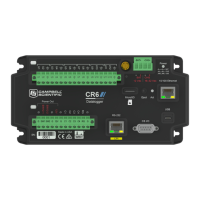Low signal strength amplitude warning
When the response amplitude is measured as less than 0.01 mV RMS, the Resonant Frequency
value reports NAN indicating that low signal strength amplitudes have occurred. The 0.01 mV
threshold can be modified in the VibratingWire() instruction.
6.6.2 Improving vibrating wire measurement quality
The following may improve measurement quality:
l Match frequency ranges to expected frequencies.
l Reject noise.
l Minimize resonant decay.
l Prevent spectral leakage.
6.6.2.1 Matching measurement ranges to expected frequencies
Measurements are best when the frequency ranges of the swept excitation and of the response
analysis match the range of resonant frequencies expected from the sensor. The swept and
analysis ranges for specific sensors are determined using the tools in Device Configuration Utility
on the VW Diagnostics tab. Once determined, the ranges are then programmed into the CRBasic
program by adjusting the BeginFreq and EndFreq parameters in the VibratingWire()
instruction.
6.6.2.2 Rejecting noise
More accurate readings can be obtained when the sensor is swept over narrower-frequency
ranges. A narrow-frequency measurement reduces noise and yields a greater signal-to-noise ratio
than a wide measurement. Sensors with frequency ranges below 450 Hz should work well even in
the presence of 50 or 60 Hz noise; however, they should be characterized.
NOTE:
Check the manufacturer specifications for the sensor frequency and excitation ranges to help
determine the swept frequency range.
6.6.2.3 Minimizing resonant decay
A narrow-swept range ensures minimal decay of the resonant response prior to measurement.
Gage response starts to decay as soon as the frequency sweep moves past the resonant
frequency. Observing this decay is difficult because the swept frequency overwhelms the
resonant-frequency response while excitation is still active. Because wider excitation sweeps take
longer, the resonant response decays for a longer time before the data logger can measure it.
The resulting resonant amplitude is smaller.
6. Measurements 87

